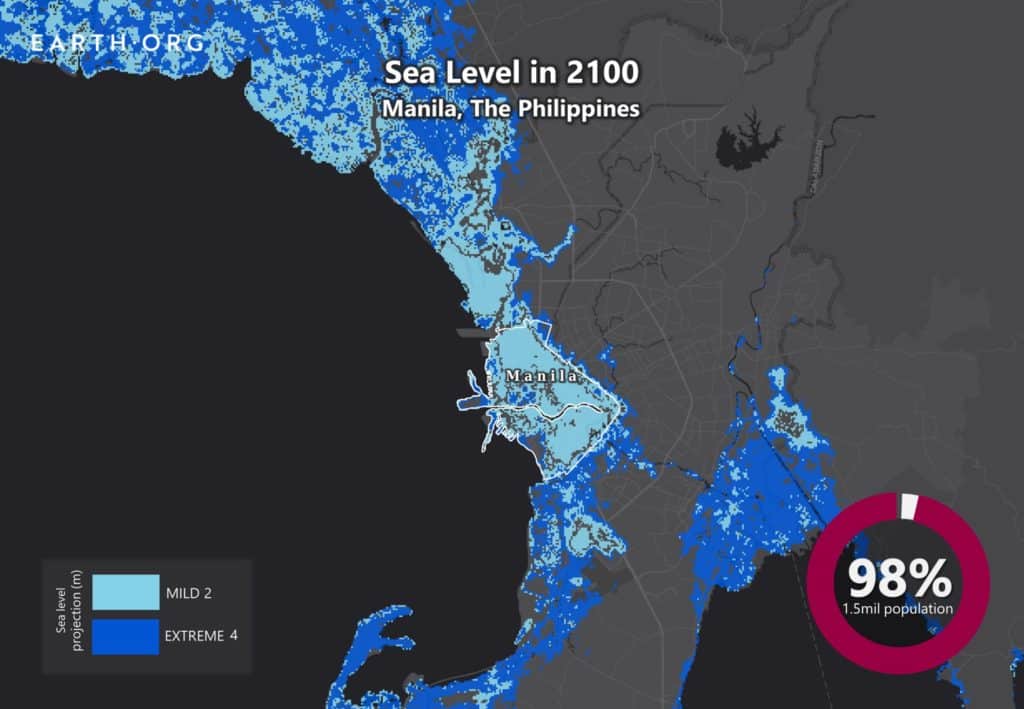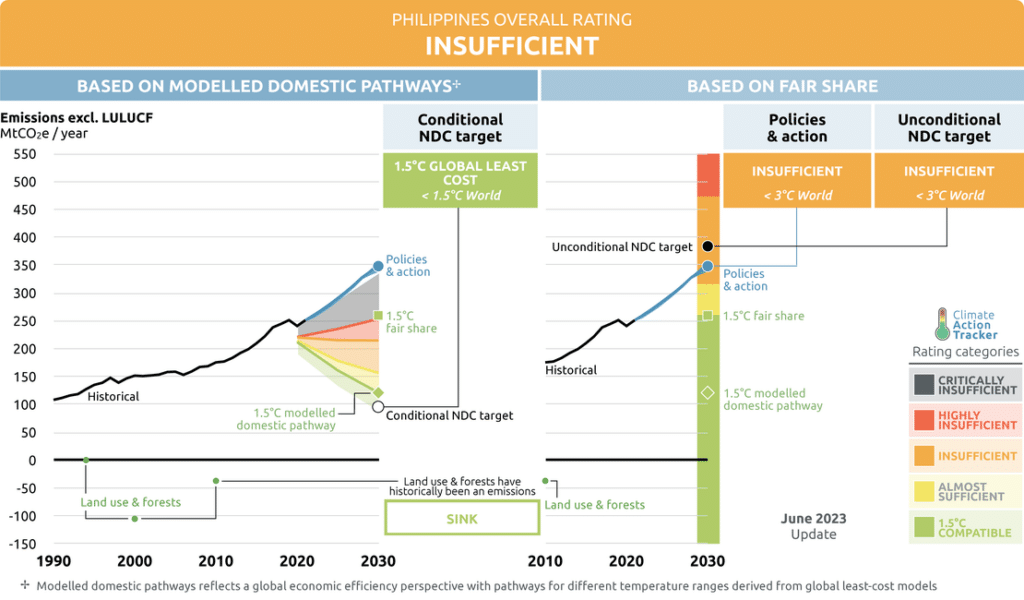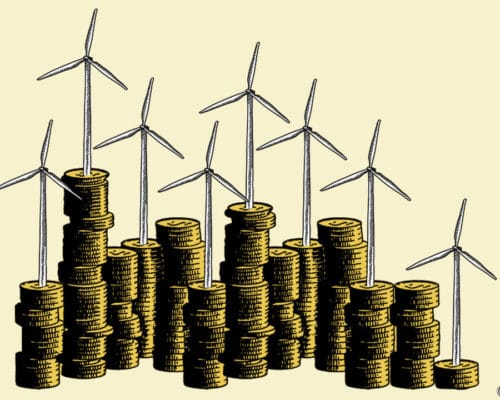Climate Change in the Philippines and Its Far-reaching Impacts
Source: Pinay Wise
06 June 2024 – by Eric Koons
Climate Change in the Philippines 2024
Climate change in the Philippines is a critical issue that impacts the country’s environment, economy and society. In fact, the country was ranked the fourth most impacted by climate change between 2000 and 2019.
Furthermore, despite being a developing country with relatively low total greenhouse gases emissions – making up 0.35% of global emissions – its per capita emissions are significant. The Philippines emitted about 1.3 metric tonnes of carbon dioxide per capita in 2022.
This and other environmental issues like deforestation directly influence the global climate system and expedite regional climate impacts.

Effects of Climate Change in the Philippines
The Philippines is highly vulnerable to climate change due to its geographic location and socioeconomic factors. This vulnerability is primarily related to its extensive coastline, high-density population centres and significant dependence on climate-sensitive natural resources. Combined, some estimates rank Philippines as the most at-risk country in the world, facing losses of 6% of its GDP annually by 2100.
Sea Level Rise
Accelerated sea level rise is a significant concern for the Philippines, which has over 36,000 km of coastline. Rising sea levels threaten to inundate coastal communities, displacing 13.6 million people and causing substantial economic losses. Research shows that the country has experienced an average sea level rise of about 60 cm, about three times higher than the global average.
This exacerbates the risk of storm surges, coastal flooding and the salinisation of aquifers, particularly in low-lying areas such as Metro Manila and the Visayas.

Sea level rise projections by 2100 for two scenarios with the amount of rise indicated in metres. Percentage and total population displacement are indicated at the bottom right. Source: Earth.org
Extreme Weather Events
The Philippines is prone to extreme climate events, including typhoons, which are declining in frequency but becoming more severe due to global warming. The country experiences an average of 20 typhoons annually, with about five being destructive.
Super Typhoon Haiyan in 2013 is a prime example of tropical storms increasing in strength. It is one of the most powerful tropical cyclones on record, affecting over 14 million people and damaging 1.1 million homes. In total, there were over 8,000 deaths and USD 13 billion in damage.
Such events devastate infrastructure, agriculture and communities, leading to significant economic and human losses.
Extreme Rainfall
Climate change is altering rainfall patterns worldwide, and the Philippines is no different. Most of the country is expected to see an increasing number of dry days and lower average rainfall, while Luzon and Visayas will see an increase in rain during the southwest monsoon season. At the same time, rainfall will become more consolidated, with days of heavy rain increasing across the country.
These changes increase the risk of flooding and landslides, particularly in areas with inadequate infrastructure, and increase the risk of drought during dry periods. Climate projections show the country will face a “high” degree of water scarcity by 2040. Changes in rainfall will continue to pose serious challenges to water management, agriculture and disaster preparedness.
Ocean Impacts
Rising ocean temperatures and acidification are also impacting the Philippines’ marine ecosystems, which are crucial for the country’s food security and economy. Coral reefs are particularly vulnerable to these climate change impacts, as higher sea temperatures lead to coral bleaching. Already, the country has lost one-third of its coral cover over the last 20 years.
The IPCC predicts that if this trend continues, fish catches will decline nearly 50% by 2051. This will be a dramatic blow to the country because the fisheries sector employs 4% of the country’s labour force and is the primary food source for 50% of households.
Climate Change Examples in the Philippines
Climate change examples in the Philippines are quite evident. For instance, the land is sinking in portions of Manila Bay due to groundwater withdrawal, while sea levels are rising. This has left several communities at constant risk of flooding during high tides, and many homes have become unliveable. This issue will continue to grow in severity in the coming decades, displacing residents and destroying existing communities.
Extreme weather events have also caused significant economic losses. The Philippines is the hardest-hit country globally, with economic losses reaching USD 12 billion annually – 3% of the country’s GDP – due to extreme weather. Studies show these extreme weather events will become more destructive due to climate crisis and illustrate the urgent need for effective climate change adaptation and resilience strategies.
Climate Policy in the Philippines
The Philippines has implemented several policies and laws to address global warming in the Philippines, but their adequacy remains a topic of debate. Climate Action Tracker rates the Philippines’ climate policies as “insufficient”.

The country’s key legislative frameworks include the Climate Change Act of 2009 and the Philippine Disaster Risk Reduction and Management Act of 2010, which aim to enhance adaptive capacity and resilience. However, implementation and enforcement challenges persist, and more robust measures are needed to meet international climate commitments and protect vulnerable communities.
Emissions Reductions
The Philippines has a conditional target to reduce greenhouse gas emissions by 75% by 2030. This is one of the most optimistic in the world, yet 72.29% of this reduction relies on international support and domestic policies that are not yet in place. Its unconditional target is just a 2.71% reduction in GHG emissions, which is the direction the country is heading. Furthermore, the Philippines remains the only ASEAN nation without a net-zero goal.
Strengthening Climate Resilience and Policy Implementation
Climate change poses several significant threats to the Philippines, impacting its coastal ecosystems, economic growth, weather patterns and marine ecosystems. While the country has made strides in formulating climate policies, more robust and effective measures are essential to mitigate these impacts, such as focusing more on renewable energy and getting the support of the private sector. Furthermore, its emissions reduction targets remain misleading with questionable decarbonisation pathways.
Addressing climate change in the Philippines requires a comprehensive approach that includes stringent policy implementation, community engagement and international cooperation to safeguard the Philippines’ future.
by Eric Koons
Eric is a passionate environmental advocate that believes renewable energy is a key piece in meeting the world’s growing energy demands. He received an environmental science degree from the University of California and has worked to promote environmentally and socially sustainable practices since. Eric’s expertise extends across the environmental field, yet he maintains a strong focus on renewable energy. His work has been featured by leading environmental organizations, such as World Resources Institute and Hitachi ABB Power Grids.
Read more







